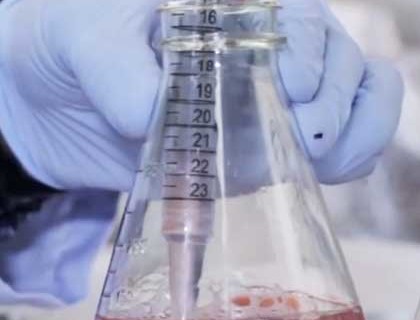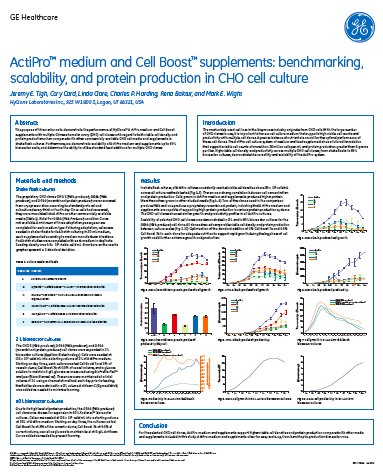
Biomanufacturing CHO Media – A look at different approaches and optimization opportunities
At this year’s BPI East conference there were several talks on CHO media including media development strategies, raw material sourcing, and impact of media on product characteristics. An area that always gets a great deal of coverage is media development and media requirements for commercial manufacturing. These discussions included the importance of balancing the need for good yield with quick timelines and product quality characteristics.
Increasingly, companies are talking about the importance of getting product candidates into the clinic as quickly as possible. As a result timelines have been further reduced and this doesn’t leave much room for lengthy media development projects. In addition, a good deal of emphasis is being placed on product quality, particularly since improved monitoring and more defined product characteristics have been developed. Media must now meet more demands than just increasing titer.
CHO Media Development Strategy Options
When thinking about product candidates, every biopharmaceutical company must make decisions about how they will handle their CHO media development from scale up through commercialization. These decisions must take into account many factors including, yield, product quality, timelines, impact on downstream purification, regulatory compliance and raw material sourcing, just to name a few. Companies may choose to develop their own platform media for all their products, use an off the shelf media, partner to create a custom formulation, or take a hybrid approach.
Off the Shelf CHO Media
Some companies may opt to use pre-made “off the shelf” CHO media and feeds particularly where a quick turnaround is desired. Companies that do not have media development capabilities already in-house and do not wish to invest heavily in a media development group or the necessary equipment may also find this option is a good fit.
There are several advantages of going with an off the shelf media, including reduced development cost and a very short timeline. With so many commercial media options available, relatively quick, easy media screening of a cell line is likely to find a good match that provides a balance of growth and productivity. In addition, when buying off the shelf media, companies do not have the added burden of sourcing raw materials and verifying the quality. Of course, companies will want to conduct a quality audit of the media company, but this is a much easier process than auditing several raw material suppliers. For more information on raw material sourcing, please see “Raw Material Sourcing for Cell Culture Media – Important Considerations”.
At BPI, GE Healthcare Life Sciences launched their optimized CHO platform media and feed system, ActiPro™. The system is  designed to provide an off the shelf alternative to lengthy platform media development. The system allows for a platform approach that can be optimized to individual cell lines using the ActiPro feed supplements. The platform media solution provides a medium that can be used from scale up through commercial manufacturing including seeding, adaptation and product production.
designed to provide an off the shelf alternative to lengthy platform media development. The system allows for a platform approach that can be optimized to individual cell lines using the ActiPro feed supplements. The platform media solution provides a medium that can be used from scale up through commercial manufacturing including seeding, adaptation and product production.
ActiPro media platform is designed for use in CHO-K, CHO-S, CHO-DG44, and CHO-GS with recommended starting concentrations provided by GE Healthcare that can be further optimized for individual cell lines. It has been demonstrated that ActiPro supports viable cell counts of more than 25 million cells per mL and high productivity with protein production reaching in excess of 5 grams per liter. For more data on ActiPro performance, please see the poster “ActiPro medium and Cell Boost™ supplements: benchmarking, scalability, and protein production in CHO cell culture.” The media and feeds are all chemically defined, protein free, animal defined component free and hydrolysate free, which provides simplified downstream purification and a less complicated regulatory filing.
An off the shelf platform media can offer a very valuable solution if a biopharmaceutical company does not already have a platform media, the current media isn’t working well or if the company has a short timeline to develop a process. This off the shelf approach provides a quick pre-optimized option, with a simplified way to customize using associated feeds. The feeds can also be used to supplement an existing platform media.
Partner to Develop a Custom CHO Media Formulation
Companies can employ a media development company to formulate a custom CHO media for their cell line. In this strategy, companies’ work closely with their media partners to provide them with the cell line, any special characteristics, process requirements, desired product quality, manufacturing equipment information and any other pertinent information. The media development company then utilizes their team of experts and equipment to test many different media combinations.
Since media development companies have all these competencies and this is their primary focus, they are able to fulfill timelines for media development much quicker than in-house development. Full base media and feeds can be formulated in 6-12 months, depending on complexity. Media companies utilize different tools for testing media formulations, initially 96 well plates and/or shake flasks are used to screen for promising candidates. Promising candidates are then selected for further testing in scale down systems to predict performance at larger scale. Some companies that have integrated equipment competencies will test in larger scale scenarios including bench top scale and pilot scale, up to 2,000 liters. Adjustments can them be made to more closely match manufacturing scale.
Once the formulation is developed, companies have a choice as to whether they want to pay an additional cost for the recipe so that they can source raw materials and mix the media themselves or if available, they can arrange to purchase the pre-mixed powder media or in some cases even liquid media. Again, an advantage of purchasing the pre-mixed media is that companies do not have to manage the entire supply chain of raw materials.
Partnering is an attractive option for companies that want to have expertise and experience without developing those competencies in-house. In a talk given at BPI by Stacy Holdread, BD Biosciences, Ms. Holdread discussed BD Biosciences’ extensive media development and screening process and the use of Roche’s Cedex Bio HT Analyzer to enable this process. She began by describing the need for BD Biosciences to be able to process more samples with respect to their media screening and development projects. They wanted to increase their throughput and eliminate bottlenecks with the use of an analyzer, but needed to select the analyzer that was the best fit for their needs. They planned to use the analyzer to QC the media, look at key metabolites, monitor culture performance, make supplement decisions in terms of what to add and when, and track culture over time. Their requirements were that the system be high throughput, provide high data quality, and meet functionality needs with low maintenance and downtime. They tested three different systems and found that the Cedex Bio HT Analyzer best met their needs and had the added bonus of requiring a very small sample volume. For more information on the use of the analyzers in process development and media screening, please see “Quality by Design – Maintaining Strict Control of Bioprocess Conditions”.
This kind of high throughput screening of media candidates is something that media companies have a great deal of expertise in and as demonstrated in this example, the proper equipment and resources to run these experiments in a short amount of time. These processes could also be implemented within a biopharmaceutical company’s media development group, but would require capital investment for equipment and employee resources for operation.
Develop CHO Media In-house
Some companies decide to develop their production CHO media in-house. Most develop a platform media designed to support several different cell lines expressing different proteins. The platform media can support early stage production with little or no optimization and later can be optimized on an as needed basis to address specific cell lines. While it is generally recognized that cell culture media development is best when it is cell line specific, it is too time consuming for companies to develop a novel media for each cell line. The platform approach allows for late stage optimization of the media and feeds to optimize productivity.
Once developed, an in-house media may provide more flexibility when purchasing raw materials or adjusting various components of the formulation. It also allows companies to know all the components of their media for regulatory purposes. However this is probably not critical with regulatory support from media companies. Companies that have a large number of products moving through their pipeline may find it is more cost effective to have a team who can do this work in-house. It may also provide the opportunity for improved workflow assuming there is good communication with cell line development and downstream purification.
One disadvantage is that the timeline is quite a bit longer to develop in-house, my sources say 18-24 months on average to develop an effective platform media in-house. Costs are also higher due to staffing requirements.
Hybrid – Develop CHO Media In-house, but Employ External Resources for Optimization
Companies can also choose to elect a combination strategy. For companies that have an existing platfor m CHO media that is not performing as expected, this could be a really valuable option. They could either partner with a media company to help them optimize for each cell line or they could screen off the shelf feeds and supplements to improve performance.
m CHO media that is not performing as expected, this could be a really valuable option. They could either partner with a media company to help them optimize for each cell line or they could screen off the shelf feeds and supplements to improve performance.
Companies can experiment with off the shelf feeds and supplements to efficiently boost performance without significant investment of resources. At BPI, there was a technology workshop given by Adam Elhofy, Ph.D., CSO, Research and Development, Essential Pharmaceuticals, titled “Increasing Protein Production with Novel Cell-Ess Supplement without Affecting Metabolic Profile”. In this talk, Dr. Elhofy described Cell-Ess, a chemically defined, animal component free serum replacement. The product is able to deliver lipids efficiently without the toxicity or oxidation found in other lipid supplements. Through efficient lipid delivery, Cell-Ess provided more efficient protein production per cell without any effect on the metabolic profile. In their poster presented at BPI, “Novel Lipid Supplement Enhances Protein Production in Small Bioreactors,” it was shown that the addition of Cell-Ess at 1% concentration to a 5 liter WAVE reactor process increased mAb production by over 25%. This supplement could provide a quick, effective way to optimize media without significant investment in development time and resources.
Summary
Deciding which strategy to follow for media development is complex and also very important. Cell culture media is an important factor in determining product yield, product quality, development timelines and cost of manufacturing. Careful analysis of company goals, timelines, budgets, and competencies are necessary in selecting the right strategy.
For more coverage of the October BPI East 2015 conference, please see:
BioProcess International Conference (BPI) 2015 – An Overview For Anyone Who Missed It!
Also don’t miss BPI West in March 2016!
A new BPI West will make its debut March 14-17, 2016 in Oakland, CA and will be the West Coast compliment to BPI East in Boston October 4-7, 2016.